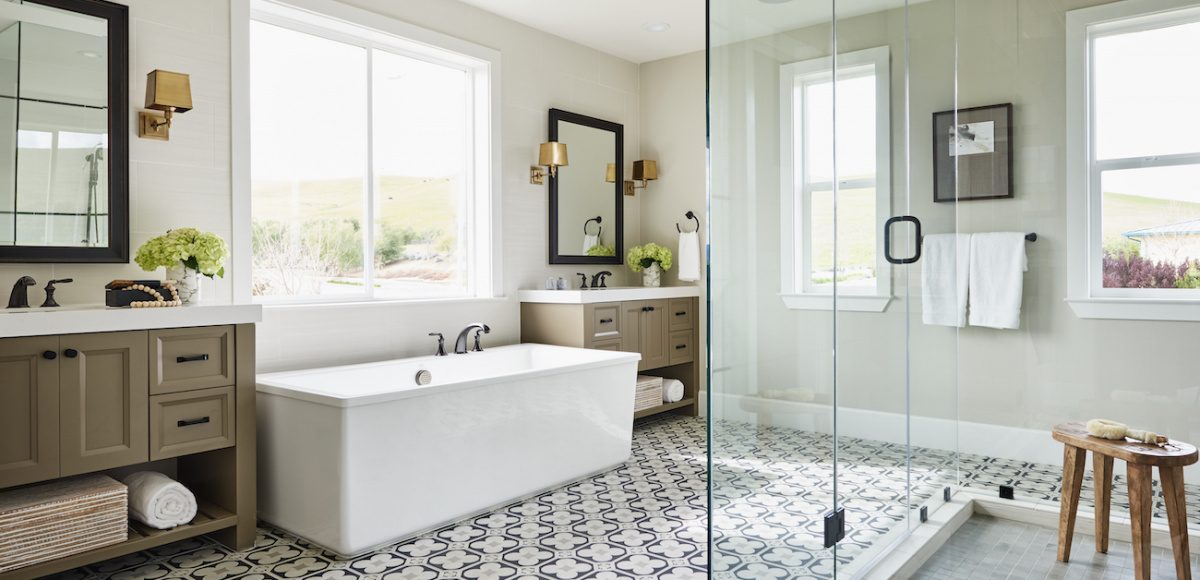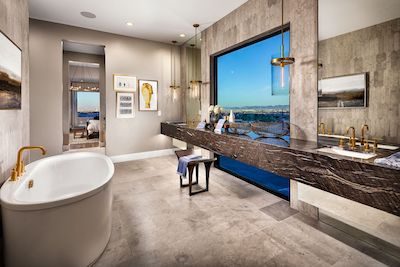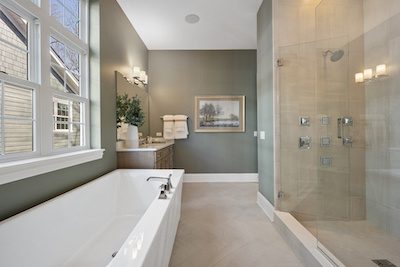3 Takeaways:
- Standalone tubs are again in demand.
- Bidets became more commonplace after toilet paper shortages at the start of the pandemic.
- The most popular bathroom tech includes dimmable lights, heated floors and towel racks, and the installation of smart speakers to listen to music and podcasts.
With many homeowners continuing to spend more time at home, they’re not only seeking comfort in their kitchens, offices, and outdoor spaces—they’re also updating their master bathrooms to create a spa-like retreat.
Looking to hotels and resorts for inspiration, homeowners are incorporating large showers with multiple faucet sprays, heated floors and towel racks, separate toilet rooms, soothing color palettes, and more, says Mary Cook, founder of the Chicago interior architecture and design firm, Mary Cook Associates.
“Dual-income, well-educated millennials are driving a desire for more bells and whistles, yet they’re choosing ones that are also practical and add value and worth,” she says.
The most common choices involve sophisticated technology, lower-maintenance materials, and aesthetics found elsewhere in their home.
Not surprisingly, costs add up, but many designers like Denise Benach, director of interior design for Chicago builder Lexington Homes, find that homeowners are willing to spend more on bathrooms. An average remodel now hovers between $10,000 and $25,00, according to HomeAdvisor.
Real estate pros should inform buyers about what’s available so they can get the look and function they want within their budget.
1. Increasing the bathroom footprint.
When houses are built or master bedroom suites added, one goal may be to gain more space. But sometimes that’s a challenge. According to a 2020 Houzz survey, the online decorating source, only 20% of homeowners increased the bathroom’s size during a renovation. Designer Sharon McCormick, whose eponymous firm is in Hartford, Conn., says some homeowners want space for seating, which reflects the role of the bathroom as more than its functional space. Jodi Swarz, head of KitchenVisions in the Boston area, is also witnessing homeowners trade extra bathroom space for an adjacent closet or maybe a dressing room.
2. Bigger, yet simpler showers.
Although a larger, better outfitted shower increases a bathroom remodeling cost threefold, adding up to $14,000, according to the Houzz report, it’s still a feature most homeowners want. Boston-area designer Diane Burcz says her clients want a walk-in shower design. Showers with a curb and linear drain may be about 69 inches wide and 66 inches deep, while those without may be a smaller 52 inches wide and 45 inches deep. Within the shower, many want to add a built-in or portable bench and smart-home plumbing fixtures that personalize the water experience. For example, they might incorporate one or two oversized rain heads that can turn on to a specified temperature and flow, says Burcz.
Broker Millie Rosenbloom, with Baird & Warner in Chicago, who's selling condos at a new mixed-use development, Parkline Chicago, agrees. “The new designs offer triple the volume of water as the old-fashioned ones did,” she says. Besides a rain head, they may want a hand-held wand. And if the homeowners are a couple, they each may have a different wish list, McCormick says. Some showerheads offer aromatherapy with different scents in the same way you choose your favorite coffee K cup, says JT Norman, business development design and innovation at Elements, the bathroom division at Nazareth, Pa.-based Kitchen Magic.
Overall, the shower look is cleaner with fewer fixtures lining walls, Burcz says. “People no longer want 14 heads to give them the effect of a car wash that blasts them from all sides and uses too much water, as some states mandate usage,” says William Strang, president of operations and ecommerce at TOTO USA.
3. Tubs with sculptural designs.
Rumors of the tub’s demise have turned out to be exaggerated. Those who have the space often want one of the newer sculptural freestanding models. Many designers find these tubs represent an artistic status symbol, says architect William Ramsey, AIA, with KTGY Architecture + Planning’s Denver office.
However, Swarz is among the designers who tries to talk clients out of them since she finds they are hard to get into and out of and not comfortable for resting arms or setting toiletries. If clients want a tub, a more practical option is a drop-in model set against a wall so a ledge can be included. For those seeking something extra, choose a model with jets and lights for chromotherapy.
4. Separate vanities and storage.
The clutter-free look is in, which means there’s a desire for more storage to stash stuff like workout clothes, hairdryers, and electric toothbrushes. More designers are creating separate storage areas for couples who share bathrooms, says Rosenbloom. Chicago designer Susan Brunstrum of Studio Brunstrum says homeowners can do their part by editing what they bring into the room. “Do you really need four bottles of shampoo and five conditioners?” she asks. Some designers also like to raise cabinetry off the floor to make heating and cleaning easier.
Having two vanities or sinks has become a must-have, says Tim Bakke, director of publishing at The Plan Collection, an online home and design company. An alternative is to use one oversized version that resembles a trough with two faucets, says Norman.
For mirrors, Swarz may incorporate a thin bar of light on one side or all around rather than use separate lights above; or she may frame the mirrors like artwork. Because of bathroom chemicals, Rosenbloom prefers quartz to granite and marble for a countertop.
5. More lighting.
The brighter the better these days, particularly when the source is natural light. Some of the Parkline Chicago condominiums have floor to ceiling windows that offer sweeping city and lake views. Skylights or transom windows are another option, says Lynn Schrage, marketing manager, online bathroom design services, for Kohler Co.
For artificial light, LEDs are showing up, often in a warm 2700 Kelvin temperature, says Ramsey. Most lighting plans feature multiple layers with recessed cans—including two in a shower or over a tub. One seemingly universal choice is putting all lamps (bulbs) on dimmers to create different experiences.
6. Larger tiles and bolder accents.
While the most popular palette remains neutral and spa-like—which helps avoid dating a room, Cook says, the specific hues have shifted to warmer greiges, a combination of gray and beige, says Gena Kirk, vice president of the Corporate Studio at Los Angeles-based KB Home.
Colorful accent colors have emerged, such as navy and emerald green, particularly along an accent wall, says Ramsey. The biggest change in color is touches of black in hardware, lighting, fixtures, or shower enclosures. “It offers a dramatic and expensive looking accent,” says Kirk. Ramsey has also mixed black with different metals. But homeowners should be aware that the black trend may have a short shelf life, Strang cautions.
Many designers also incorporate larger format tiles as big as 24 inches by 24 inches as another accent. They offer the plus of being able to be cleaned easily since they require less grout. New hexagonal-shaped tiles have become popular, though Ramsey thinks this look, too, already is fading.
7. Smart toilets and bidets.
Several trends are gaining momentum: installing a toilet from the wall rather than the floor, concealing the tank in the wall, and adding a commodes cubicle or closet, says Schrage. Wall mounted designs leave more floor space and make it easier to clean underneath. At some luxurious developments such as Mesa Ridge in Las Vegas, Ramsey says two toilets are commonplace.
Due to the larger boomer population, higher or comfort-level ADA toilets have gained interest. The paper toilet shortage at the start of the pandemic also led to greater interest in bidets. Some companies like TOTO USA and Kohler have designed seats that can fit onto an existing toilet, and the latest technology offers features to dry, deodorize, heat the seat and water, have the water pulsate or oscillate, spray a bowl clean after every use, conserve water, and open and close a lid automatically.
8. Speakers and other smart features.
The trend for including a TV in the bathroom for news and entertainment is fading as interest turns to smart speakers for playing music and podcasts. Touchless faucets, which have become commonplace in commercial settings, are starting to gain popularity in homes, too, says Schrage.
9. Touches of nature.
It’s become well known that nature offers a soothing touch and a sense of healthfulness. Brunstrum suggests bringing in a live plant or two and maybe using a botanical print wallpaper that can hold up to water and moisture. Wallpaper is usually an accent in one area, such as a toilet room. A final must have is a good ventilation system to pare humidity, Schrage says.
5 Quick Tips for a New, Hipper Shower
- Smart shower devices let each user set the temperature they desire.
- Steam features add to the spa-like experience, says Swarz.
- Some homeowners want the shower and tub to be part of an open “wet room,” a Japanese design concept.
- A heated shower floor provides added luxury, says Rosenbloom.
- Despite the larger “super” shower trend (especially when homeowners forego the tub), some are paring their showers to 48 inches wide by 60 inches deep to retain heat, says Ramsey.













